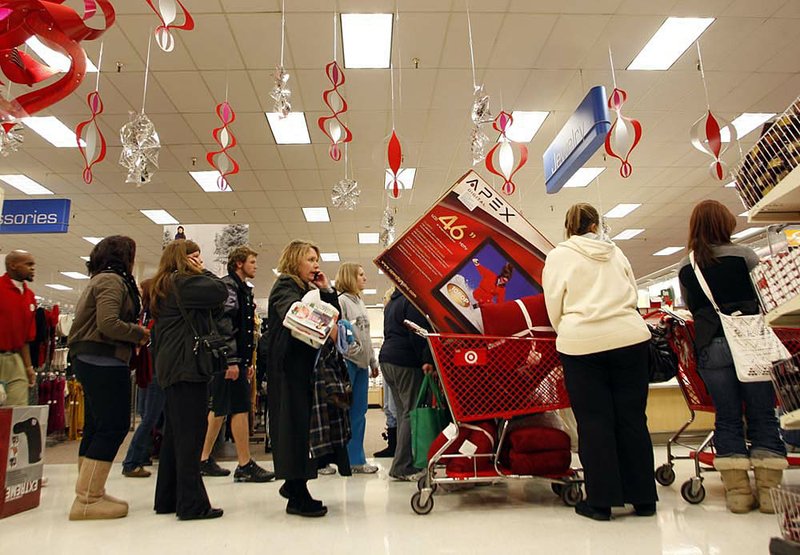LITTLE ROCK — The average shopper in the U.S. spent 6.4 percent more over Thanksgiving weekend than last year as more people picked up jewelry and toys, heartened by the economic rebound.
About 212 million shoppers went to stores and websites over Black Friday weekend, on average spending $365.34, the National Retail Federation said Sunday. The proportion of sales online rose to more than one-third of the total, the highest ever, according to the Washington-based trade group.
Wal-Mart Stores Inc.’s online marketplace, walmart. com, said Monday in a release that traffic increased nearly 30 percent on Black Friday compared with last year and was up nearly 50 percent on Thanksgiving Day compared with last year.
U.S. retail sales during Thanksgiving weekend totaled about $45 billion, the retail federation said, citing a survey conducted by BIGresearch. More people are scouring for deals earlier, with the number of customers shopping on Thanksgiving Day more than doubling over the past five years, the group said.
ShopperTrak, a Chicago based research firm, said Monday that customer traffic rose 2.8 percent for Thanksgiving weekend, making up for a 1.1 percent decline in 2009, but shoppers were focused on deals.
Sales for the weekend totaled $20.48 billion, compared with $20.49 in 2009, which was 1.6 percent more than in 2008, according to ShopperTrak. Revenue edged up 0.3 percent for Friday, fell 0.9 percent for Saturday and rose 0.5 percent for Sunday compared with 2009. ShopperTrak monitors sales at 70,000 stores, not including Wal-Mart, Target Corp. or other discounters, and does not include online sales.
The firm expects Christmas sales overall to rise 3.2 percent.
Almost nine in 10 retailers had special promotions planned for Cyber Monday, according to Shop.org, a division of the Washington-based trade group. The retail federation coined the term Cyber Monday in 2005, promoting the idea that people, upon returning to work, would log onto their computers there and shop.
IBM’s Coremetrics predicts the discounts, free shipping offers and other come-ons will make Cyber Monday the busiest online shopping day of the season.
Online research firm com-Score reported late Sunday that e-commerce spending for the first 26 days of November rose 13 percent, reaching $11.64 billion, compared with the same period a year ago.
Online spending is still a relatively small piece of the Christmas shopping pie, between 8 and 10 percent by various estimates.
While Black Friday is expected to be the busiest day of the year, more spending was pulled forward as stores from Best Buy to Sears promoted discounts on Christmas items earlier in the month, often pitching them as “Black Friday doorbusters” weeks before the real thing. More stores opened on Thanksgiving, too.
“You are going to have to look at the overall month, instead of just Black Friday,” said Laura Gurski, retail practice leader at A.T. Kearney.
A fuller picture on spending will come Thursday when retailers report November revenue figures.
The increase in Black Friday sales follows improvements in consumer sentiment. Confidence among U.S. consumers increased more than forecast in November to the highest level in five months, according to the Thomson Reuters/University of Michigan index. Consumer spending accounts for about 70 percent of U.S. gross domestic product.
“Consumers are more comfortable spending again, and that trend has held up,” Maggie Taylor, a vice president at Moody’s Investors Service in New York, said Sunday. “I don’t think people are as worried about losing their jobs anymore.”
More shoppers surveyed said they visited department stores this year, and fewer went to discounters as shoppers put more emphasis on service and selection, Ellen Davis, a retail federation spokesman, said on a conference call Sunday. Men outspent women as they shopped for electronics and other big-ticket items, often for themselves, Davis said.
Analysts are also closely watching stores’ inventory levels. Earlier this fall, many retailers worried they’d ordered too much merchandise aimed at Christmas shoppers in the spring when the economic recovery had looked like it was gaining steam.
Dana Telsey, CEO of Telsey Advisory Group, said Sunday that she believed inventories were appropriate and retailer profits aren’t in danger yet. Dec. 15-25, which accounts for 40 percent of Christmas business, will tell the tale.
“It’s the crux of the season,” she said.
Information for this article was contributed by Lauren Coleman-Lochner, Yi Tian and Joseph Galante of Bloomberg News and by Anne D’Innocenzio and Chip Cutter of The Associated Press.
Front Section, Pages 1 on 11/30/2010
